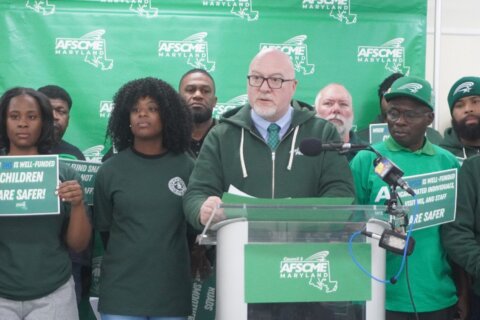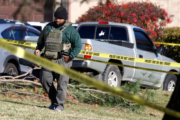This article was republished with permission from WTOP’s news partners at Maryland Matters. Sign up for Maryland Matters’ free email subscription today.
This content was republished with permission from WTOP’s news partners at Maryland Matters. Sign up for Maryland Matters’ free email subscription today.
The committee charged with selecting nominees to oversee the Blueprint for Maryland’s Future education reform plan has declined to send a new slate of potential appointees to Gov. Lawrence J. Hogan Jr. (R) after he cited concerns about a lack of diversity among their nominees.
“The Committee worked diligently to meet its statutory charge to select qualified nominees with expertise in the areas specified in the law and, to the extent practicable, that represent the diversity of the State. We are confident that we have fulfilled our charge,” the nominating committee’s chair Shanaysha Sauls and its vice chair Sen. Paul Pinsky (D-Prince George’s) wrote in a letter to Hogan on Sept. 17.
The Accountability and Implementation Board (AIB) will be responsible for ensuring that the state and local jurisdictions fully implement the multi-billion-dollar Blueprint education reforms, which aim to close student achievement gaps and transform Maryland’s education system over the next decade.
Earlier this month, Hogan wrote to the nominating committee that he’d received letters from Prince George’s County Executive Angela Alsobrooks (D) and the Maryland Legislative Latino Caucus, expressing disappointment that the slate of nominees they recommended did not include residents from Prince George’s County or Latino communities.
However, one nominee has worked at Prince George’s Community College for 29 years — a fact Alsobrooks noted, but said was not the same as having a county resident.
Two other nominees have ties to the University of Maryland, College Park, which is in the county.
Hogan asked the nominating committee to reopen the application process and “provide a slate of nominees that accurately reflect our student population” by Sept. 27.
Hogan is required to select seven nominees to the AIB by Oct. 1.
The nominating committee did not vote to decline Hogan’s request for a new slate of nominees, Sauls said. Rather, she consulted with the Attorney General’s Office and found that the committee is not required to submit additional names to the governor.
Although the governor can request a new slate of nominees, “there’s nothing in the law that requires us to scrap the process and start all over,” Sauls said.
The AIB will have the opportunity to hear from the public about any concerns they may have, Sauls said.
She also noted that AIB members have staggered terms, with three members’ terms ending in 2023, two ending in 2024 and two ending in 2025. Those concerned about diversity of the board can seek qualified candidates from certain demographic and geographical areas to apply for the next terms, Sauls said.
“It’s not like these people have lifetime terms — it’s not the Supreme Court,” Pinsky said. “There are going to be opportunities for other people to apply and be selected; this is not in perpetuity.”
Pinsky contended that the nominating committee did their duty. With only seven seats on the AIB, it is not possible to have representation from all 24 Maryland jurisdictions, Pinsky said.
“I think there is a misunderstanding of the role of the AIB,” Pinsky said. The AIB is not tasked with developing new policies or funding formulas, he said. Rather, policies affecting each county are already set in law and having a representative on the AIB from a specific county is not going to affect those policies in that county, he continued.
“I think people are overestimating the latitude that the AIB has,” Pinsky said. Anyone had an opportunity to propose amendments to the Blueprint bill in the legislative process if they thought parts of it were exclusionary or unfair, Pinsky continued.
However, Del. David Fraser-Hidalgo (D-Montgomery) said that the nominating committee should reconsider their decision and resubmit nominees for Hogan to choose from that is more representative of the population in Maryland.
“Almost 12% of the population in Maryland is Latino, and in various school districts, Latinos make up 30% to 40% of the population of students,” said Fraser-Hidalgo, who is chair of the Maryland Legislative Latino Caucus.
“The simple fact of the matter is these seven people are going to be tasked, in some way, to help ensure education policy in the state, so they should be representative of the demographics of the state of Maryland,” he said. “To have nobody representing them is extraordinarily concerning.”
Del. Joseline A. Peña-Melnyk (D-Anne Arundel and Prince George’s), vice chair of the Maryland Legislative Latino Caucus, said that she is “extremely disappointed that the committee could not see the importance of diversity and inclusion.”
On Monday, Prince George’s County Executive Angela Alsobrooks called for Prince George’s residents who are interested in serving on the AIB to submit a resume and cover letter to the county executive’s office by Friday.
The intent was to collect names of Prince George’s residents who might be interested on serving on the AIB so the county could send additional candidates to the nominating commission in case the committee decided to reopen applications, said John Erzen, Alsobrook’s deputy chief of staff.
Despite the nominating committee’s decision, Prince George’s County still plans to send the roughly half dozen applications collected to the nominating committee to consider for the future, Erzen said.
“We understand their decision, and we look forward to working with the members of the AIB who are selected to implement this historic legislation,” Erzen said.
Sauls said Wednesday that she has not heard back from Hogan’s office.
But Hogan spokesman Michael Ricci criticized the nominating committee’s decision.
“The law requires the committee to submit a slate of names that reflects the diversity of the state, and it has not even come close to doing so. There’s no representation from the second most populous jurisdiction, no Latino representation, no representation from anywhere in Western Maryland or the Eastern Shore,” Ricci said.
According to the Blueprint legislation, the AIB shall consist of individuals who “reflect, to the extent practicable, the geographic racial, ethnic cultural, and gender diversity of the State.”
The governor’s insistence on more diversity and inclusiveness on the committee stands,” Ricci said.
However, Ricci did not say whether Hogan plans to select AIB members from the nominees the committee sent to him.
Shamoyia Gardiner, executive director of Strong Schools Maryland, a grassroots organization advocating for the Blueprint, said that she thinks the nominating committee’s decision “follows the letter of the law and also recognizes the timeline that we are in.”
“I think the nominating committee’s decision is ultimately the correct decision. We only have until February 15th [to adopt an implementation plan] and I can’t ring this bell enough,” she said.
“The visible representation of AIB members is a really important thing, but it is not the entire picture,” she said. If someone feels like their community is not being reflected in the state Blueprint plan, then they can advocate at the local level and ensure that it is included in the local Blueprint plan, Gardiner continued.
“That is still power; that is still a way of impacting the community and ensuring that voices that are not represented the way we want to see them on the AIB are represented locally and still achieve the same outcome — world-class schools for all kids,” Gardiner said.







